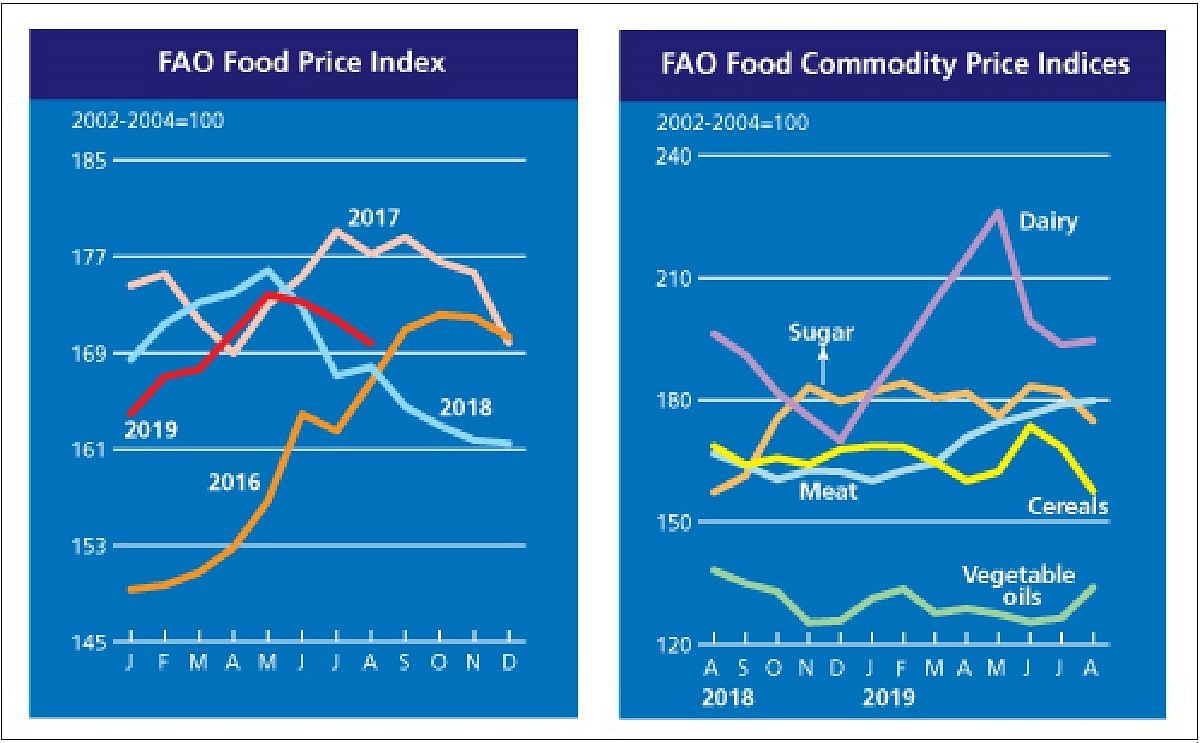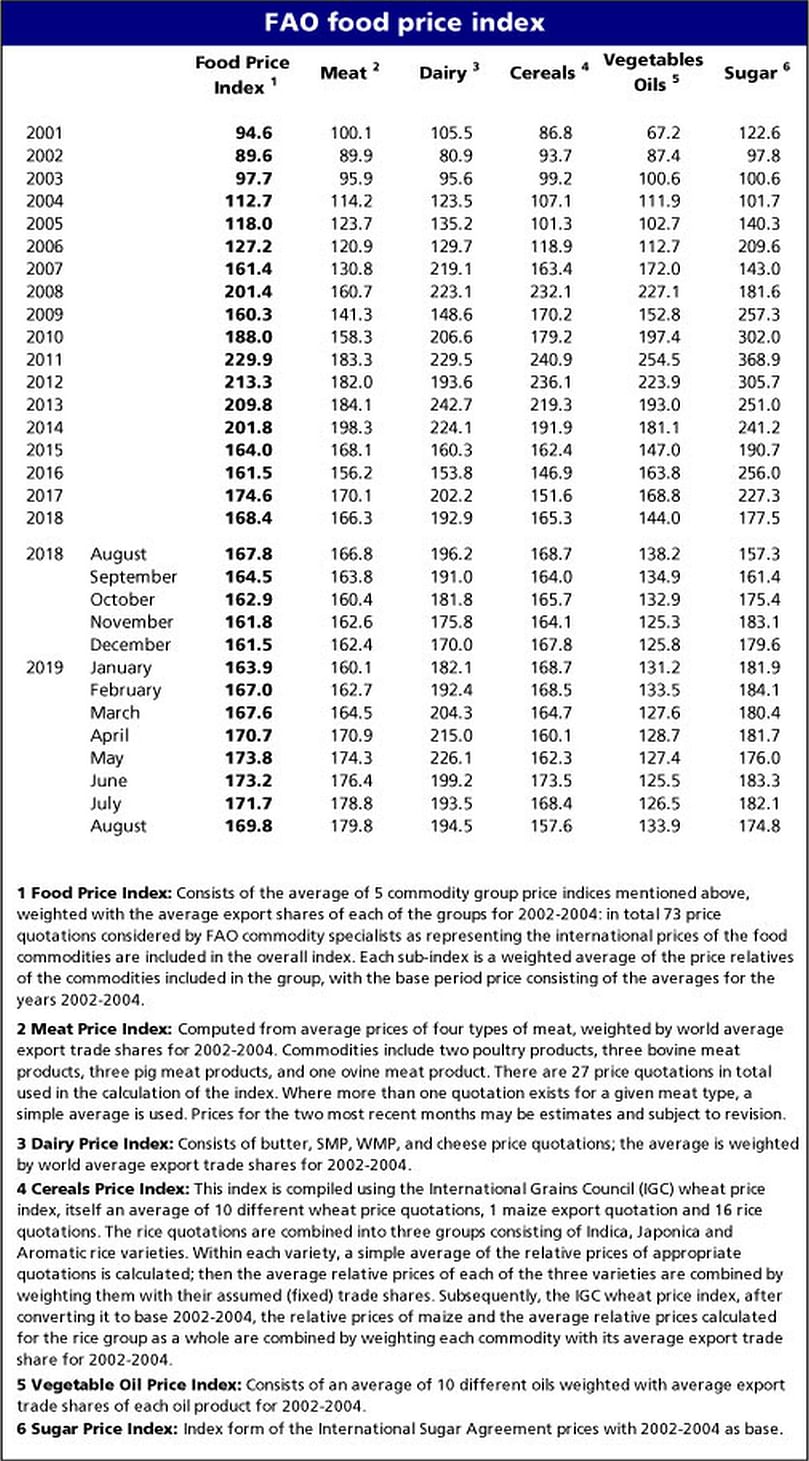The FAO Food Price Index* (FFPI) averaged 169.8 points in August 2019, down 1.1 percent (almost 2.0 points) from July but still 1.1 percent higher than in August 2018.
FAO Food Price Index fell in August 2019 but remained above the level of last year

The FAO Food Price Index* ((FFPI) averaged 169.8 points in August 2019, down 1.1 percent (almost 2.0 points) from July but still 1.1 percent higher than in August 2018. The decline in August marked the third consecutive monthly decrease in the FFPI, with the latest drop reflecting sharp falls in the prices of sugar and leading cereals, outweighing increases in all other sub-indices, especially vegetable oils.
The FAO Cereal Price Index averaged 157.6 points in August, down by as much as 6.4 percent (10.8 points) from July and 6.6 percent (11.1 points) from the corresponding month last year. Similar to the drop in July, the fall in the value of this sub-index in August reflects sharp declines in the prices of wheat and major coarse grains, particularly maize.
Wheat prices remained under downward pressure, influenced by large export availabilities and, hence, increased competition among the major exporters.
Maize values also turned sharply lower in August, primarily because of expectation of a much larger-than-earlier anticipated harvest in the United States, the world’s largest producer and exporter of maize.
By contrast, international rice prices edged up in August, underpinned by seasonal tightness in northern hemisphere suppliers and in Thailand because of concerns over the impact of weather on crops.
The FAO Vegetable Oil Price Index averaged 133.9 points in August, up 7.5 points (or 5.9 percent) from July and marking an 11-month high.
The increase reflects firmer values for palm and several other oils. International palm oil price quotations surged, underpinned by a rebound in global import demand and lower than expected inventory levels in Malaysia.
Moreover, Indonesia reported unfavourable weather conditions in major growing regions, fueling concerns over future supplies. With regards to soy oil, robust demand from both the food and the biodiesel sectors provided support to prices, along with reports of lower than anticipated crush volumes in the United States.
Similarly, rising demand from biodiesel producers in the European Union bolstered international rapeseed oil prices.
The FAO Meat Price Index* averaged 179.8 points in August, up 0.5 percent (nearly 1 point) from its revised value for July, continuing the trend of moderate month-on-month price increases shown since February.
With the latest increase, the index value stands 12.3 percent above its level in January 2019 and 7.8 percent above the corresponding month last year.
In August, price quotations for pigmeat strengthened further, underpinned by a strong import demand from Asia, principally China, where the African Swine Fever (ASF) continued to limit domestic pigmeat production.
Despite strong import demand, poultry and ovine meat price quotations remained steady, reflecting increased export availabilities from the main producing regions. While international trade in bovine meat remained robust, its price quotations denominated in USD declined marginally, reflecting the weakening of national currencies of some large exporting countries, including Australia.
The FAO Dairy Price Index averaged 194.5 points in August, up 0.5 percent (1 point) from July, indicating a reversal from the sharp falls registered in the two preceding months and placing the index value only marginally (0.8 percent) below its level in the corresponding month last year.
In August, price quotations for cheese, Skim Milk Powder (SMP) and Whole Milk Powder (WMP) all rose, reflecting higher import demand for near-term deliveries, as market activities began normalizing with the end of the summer recess in the northern hemisphere.
By contrast, price quotations for butter fell for the third consecutive month due to weaker demand, further accentuated by market optimism that Oceania’s export availabilities will rise in the new production season.
The FAO Sugar Price Index averaged 174.8 points in August, down by 4.0 percent (7.3 points) from July 2019. The latest month-on-month decline in international sugar prices largely comes on the back of a weakening Brazilian real, which tends to incentivize sugar exports. Prospects of larger shipments by India and Mexico in 2019/20 further weighed on sugar price quotations.













